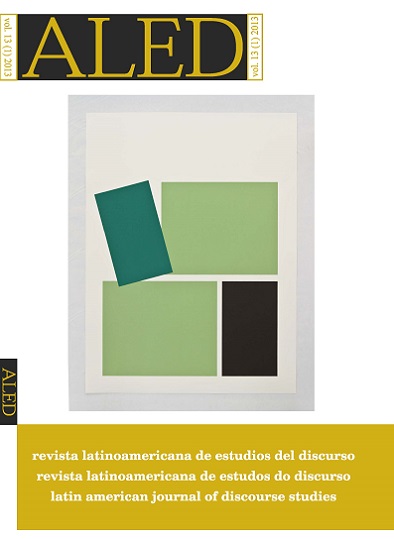La ciudad y el campo como referentes de identidad en adolescentes mapuches de Temuco y Santiago
Keywords:
identity. place-identity. urban identity. Mapuche identity.Abstract
The spaces of city and countryside are described in this article as well as the role that these play in the identity construction of Mapuche youngsters from Temuco and Santiago. The study is qualitative and descriptive and the data is analyzed through discourse analysis and the spatial identity approach (Proshansky, 1978). The sample consists of semi-structured interviews and is representative of urban Mapuche youngsters from Temuco and Santiago. The results indicate that the discursive constructions of spaces, such as the ‘city’ and ‘countryside’, are framed mainly into two modes of identification (previously stated by Dixon and Durrheim, 2000): belonging and attachment. The notion of countryside evokes a particular context in which some social, cultural and linguistic aspects are revealed. In the countryside, unlike in the city, attachment is expressed as related to types of affectivity linked to Mapuche socialization practices.
Downloads
References
ABARCA, G. (2002). Mapuches de Santiago. Rupturas y continuidades en la recreación de la cultura. Tesis de Magister en Educación Intercultural Bilingüe. PINS, PROEIB Andes, Plural Editores.
ABELL, J., CONDOR, S. y STEVENSON, C. (2006). ‘We are an island’: Geographical imagery in accounts of citizenship, civil society, and national identity in Scotland and in England. Political Psychology, 27: 207”“226.
ARAVENA, A. (2000). La identidad indigena en los medios urbanos: Proceso de recomposicion de la identidad etnica mapuche en la ciudad de Santiago, en: G. Boccara y S. Galindo (eds.) Logica mestiza en America, pp. 165-199. Temuco, Chile: Instituto de Estudios Indigenas, Universidad de la Frontera.
BREAKWELL, G. (1986). Coping with threatened identities. London: Methuen.
CASTELLS, M. (1999) La era de la información: Economía, sociedad y cultura. Volumen II: El poder de la identidad. México: Siglo Veintiuno Editores.
CUMINAO, C. (1998). Gijatun en Santiago una forma de reconstrucción de la identidad mapuche. Tesis de Antropología, Santiago de Chile, Universidad de Humanismo Cristiano.
CSIKSZENTMIHALYI & ROCHBERG-HALTON, (1981) The meaning of things. Cambridge, MA: Cambridge University.
DESPRES, C. (1991). The meaning of home: Literature review and directions for further research and theoretical development, Journal of Architecture and Planning Research, 8 (2): 96-115.
DIXON, J. y DURRHEIM, K. (2000). Displacing place identity: A discursive approach to locating self and other, British Journal of Social Psychology, 39: 27”“44.
DIXON, J. A. y REICHER, S. (1997). Intergroup contact and desegregation in the new South Africa, British Journal of Social Psychology, 36:361”“381.
DIXON, J., LEVINE, M. & MCAULEY, R. (2006). Locating impropriety: streetdrinking, moral order, and ideological dilema of public space, British Journal Political Psychology, 27: 187-206.
DURÁN, T. (1986). La identidad mapuche: un problema de vida y de concepto, América Indígena, 46(4): 698-717.
EDWARDS, D., & POTTER, J. (1992). Discursive psychology. London:Sage.
EDWARDS, D. (1997). Discourse and cognition. London: Sage Publications Ltd. Impreso.
FOX, H. (2001). En torno a la identidad urbana, Urbano, 4(4). [en línea]. Disponible en: http://www.redalyc.org/articulo.oa?id=19840419 [fecha de consulta: 7 de mayo de 2012].
GIANNELLI, L. (2006). Dominios y redes de empleo del mapuzungun en el marco rural mapuche, Signos Lingüísticos, 10 (5): 99-122.
GIDDENS, A. (2002). Modernidade e identidad. (Traducido por Plínio Dentzien). Río de Janeiro: Jorge Zahar Editores.
GISSI, N. (2002). Los mapuche en el Santiago del siglo XXI: desde la ciudadanía política a la demanda por el reconocimiento, Werkén, 3: 5-19.
JEFFERSON, G. (2004). Glossary of transcript symbols with an introduction, en G. H. Lerner (ed.) Conversation analysis. Studies from the first generation, pp. 13-31. Amsterdam: John Benjamins.
LARRAÃN, J. (2001). Identidad chilena. Buenos Aires: LOM Editores. LYNCH, K. (1998). La imagen de la ciudad. Barcelona: Gustavo Gili S.A.
NASAR, J.L. y KANG, J. (1999). House style preferences and meanings across taste cultures, Landscape and Urban Planning, 44: 33-42.
PRETTY, G. H., CHIPUER, H. M. y BRAMSTON, P. (2003). Sense of place amongst adolescents and adults in two rural Australian towns: The discriminating features of place attachment, sense of community and place dependence in relation to place identity, Journal of Environmental Psychology, 23(3): 273-287.
PROSHANSKY, H. M., FABIAN, A. K. y KAMINOFF, R. (1983). Place-identity: physical world socialization of the self, Journal of Environmental Psychology, 3: 57- 83.
PROSHANSKY, H. (1976). The appropriation and misappropriation of space, en P. Korosec (ed.) Appropriation of space. Proceedings of the Strasbourg Conference, pp. 31-45. Louvain-la-Neuve: CIACO.
PROSHANSKY, H. (1978). The city and self-identity, Environment and Behavior, 10 (2): 147-169. RAPOPORT, A. (1982). The meaning of the built environment. London: Sage.
ROWLES, G. (1983). Place and personal identity in old age: Observations from Appalachia, Journal of Environmental Psychology, 3: 299”“313.
REBOLLEDO, L. (1995). Los cambios de “personalidad” en mujeres mapuche migrantes. Consideraciones en torno a la identidad, en M. Barrig. y N. Henríquez (Comp.) Otras pieles. Género, historia cultura, pp. 51-71. Lima: Pontificia Universidad Católica del Perú.
SPELLER, G. (2000). A community in transition: A longitudinal study of place attachment and identity process in the context of an enforced relocation. Tesis Doctoral. University of Surrey, Guildford, England.
UZZELL, D., POL, E. y BADENAS, D. (2002). Place identification, social cohesion and environmental sustainability, Environment and Behavior, 34: 26”“53.
Downloads
Published
How to Cite
Issue
Section
License

This work is licensed under a Creative Commons Attribution-NonCommercial-NoDerivatives 4.0 International License.
The authors retain the copyright and guarantee RALED the right to be the first publication of the work as well as a Creative Commons Attribution License that allows others to share the work with recognition of authorship and the initial publication in this journal.




